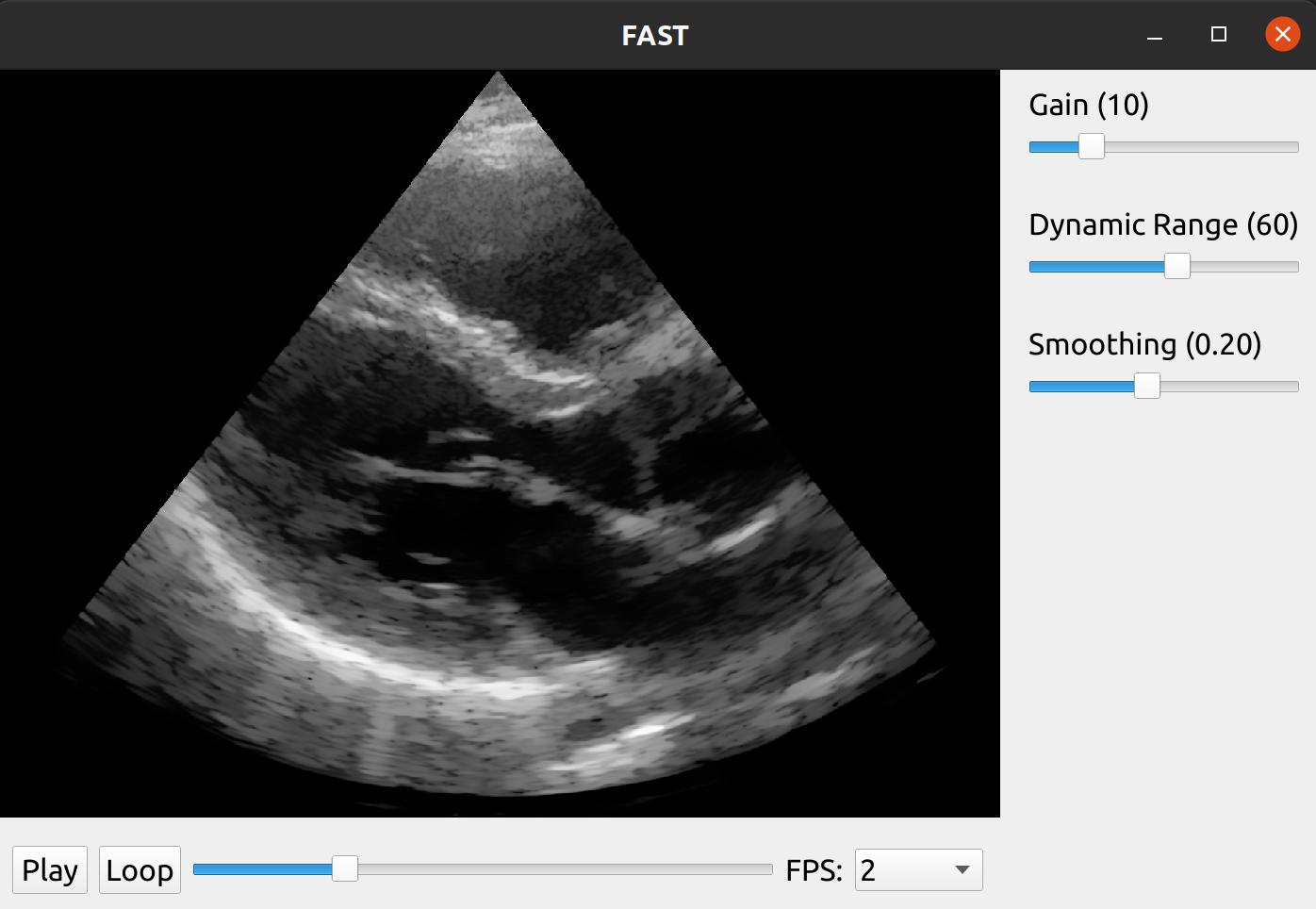vbeam.py source
This example shows how to use vbeam by Magnus Kvalevåg to beamform ultrasound channel data stored in the ultrasound file format (UFF) in python and then process the resulting IQ data to end up with a scanconverted filtered image on screen.
This example shows how to use vbeam by Magnus Kvalevåg to beamform ultrasound channel data stored in the ultrasound file format (UFF) in python and then process the resulting IQ data to end up with a scanconverted filtered image on screen. Note that this example requires you to install vbeam and jax. It has been tested with version vbeam==1.05 and jax==0.4.16

To do this we first create a custom PythonRandomAccessStreamer with FAST where we use vbeam to load and beamform some UFF data as shown below.
from time import sleep from typing import Union import fast import jax.numpy as np import pyuff_ustb as pyuff import vbeam.scan from vbeam.data_importers import import_pyuff, parse_pyuff_scan from vbeam.scan import sector_scan, linear_scan, LinearScan, SectorScan import jax from vbeam.beamformers import get_das_beamformer class VbeamStreamer(fast.PythonRandomAccessStreamer): """ Stream data from vbeam beamformer """ def __init__(self, uff_file: str, grid_width: int = 256, grid_depth: int = 512, framerate: int = 2, scan: Union[vbeam.scan.Scan, None] = None, max_depth: Union[float, None] = None, is_sector_scan: Union[bool, None] = None): super().__init__() self.createOutputPort(0) self.uff_file_path = uff_file self._data = None self.channel_data = None self.scan = scan self.grid_width = grid_width self.grid_depth = grid_depth self.N_frames = None self.setFramerate(framerate) self.is_sector_scan = is_sector_scan self.max_depth = max_depth def getNrOfFrames(self): """ This function must return how many frames the streamer has. :return: nr of frames """ if self.N_frames is None: self.initialize() return self.N_frames def initialize(self): """ Read from UFF file :return: """ print('Reading UFF ...') uff = pyuff.Uff(self.uff_file_path) self.channel_data = uff.read("/channel_data") self.N_frames = self.channel_data.N_frames try: self.scan = parse_pyuff_scan(uff.read('/scan')) print('Got scan from UFF file.') except: # Scan is missing from file print('Scan was not found in the UFF file.') def generateStream(self): if self.channel_data is None: self.initialize() # Beamform setup = import_pyuff(self.channel_data, scan=self.scan) frame_metadata = {} if self.max_depth is None: max_depth = self.channel_data.N_samples * ( 1.0 / self.channel_data.sampling_frequency) * self.channel_data.sound_speed * 0.5 else: max_depth = self.max_depth if self.scan is None: if self.is_sector_scan is None: raise ValueError('scan or is_sector_scan was not provided to VBeamStreamer constructor. Please provide one of these.') elif self.is_sector_scan: print(f'No scan provided. Creating a sector scan with max_depth {max_depth}, and grid size {self.grid_width}x{self.grid_depth}') scan_angles = np.array([wave.source.azimuth for wave in self.channel_data.sequence]) scan_depths = np.linspace(0, max_depth, self.grid_depth) scan = sector_scan(scan_angles, scan_depths).resize(azimuths=self.grid_width) else: print(f'No scan provided. Creating a linear scan with max_depth {max_depth}, and grid size {self.grid_width}x{self.grid_depth}') scan_lines = np.linspace(self.channel_data.probe.geometry[0, 0], self.channel_data.probe.geometry[0, -1], self.grid_width) scan_depths = np.linspace(self.channel_data.probe.element_height, max_depth, self.grid_depth) scan = linear_scan(scan_lines, scan_depths) setup.scan = scan else: setup.scan = self.scan if isinstance(setup.scan, LinearScan): frame_metadata['isPolar'] = 'false' frame_metadata['startRadius'] = str(setup.scan.z[0]) frame_metadata['stopRadius'] = str(setup.scan.z[-1]) frame_metadata['startTheta'] = str(setup.scan.x[0]) frame_metadata['stopTheta'] = str(setup.scan.x[-1]) elif isinstance(setup.scan, SectorScan): scan_angles = np.array([wave.source.azimuth for wave in self.channel_data.sequence]) frame_metadata['isPolar'] = 'true' frame_metadata['startRadius'] = str(0) frame_metadata['stopRadius'] = str(max_depth) frame_metadata['startTheta'] = str(scan_angles[0]) frame_metadata['stopTheta'] = str(scan_angles[-1]) print('Setting up beamformer ...') beamformer = jax.jit(get_das_beamformer(setup, scan_convert=False, log_compress=False)) print('Beamforming now ...') self._data = beamformer(**setup.data) print(self._data.shape) if len(self._data.shape) == 2: # Missing temporal dimension because only 1 frame, add it: self._data = np.expand_dims(self._data, axis=0) print('Beamforming done') while not self.isStopped(): # First, we need to check if this streaming is paused if self.getPause(): self.waitForUnpause() # Wait for streamer to be unpaused pause = self.getPause() # Check whether to pause or not frame = self.getCurrentFrameIndex() data = self._data[frame, ...].T data2 = np.transpose(np.stack([data.real, data.imag]), axes=(1,2,0)) # Rearrange data for FAST image = fast.Image.createFromArray(data2._value) # ndarray data is in _value image.setFrameData(frame_metadata) if frame == self.getNrOfFrames()-1: # If this is last frame, mark it as such image.setLastFrame('VBeamStreamer') if not pause: if self.getFramerate() > 0: sleep(1.0/self.getFramerate()) # Sleep to give the requested framerate self.getCurrentFrameIndexAndUpdate() # Update the frame index to the next frame try: self.addOutputData(0, image) self.frameAdded() # Important to notify any listeners except: break def refresh(self): # FIXME Get a 1 frame glitch when first doing this. Old frame in memory? if self.getPause(): self.setCurrentFrameIndex(self.getCurrentFrameIndex())
We can now use this streamer in a FAST pipeline were we apply some simple envelope and log compression to the IQ data and then scan convert and filter the final image using Non-Local Means. We can also add some slider widgets to the window to let the user control the gain, dynamic range and smoothing amount as well as playback widget to easily play/stop and scroll in the recording.
import fast from vbeam.util.download import cached_download from vbeam_streamer import VBeamStreamer # UFF dataset to download and run data_url = "http://www.ustb.no/datasets/Verasonics_P2-4_parasternal_long_small.uff" #data_url = "http://www.ustb.no/datasets/PICMUS_carotid_cross.uff" #data_url = "http://www.ustb.no/datasets/PICMUS_carotid_long.uff" # Setup vbeam streamer streamer = VBeamStreamer.create(cached_download(data_url), is_sector_scan=True) # Setup processing chain logCompress = fast.EnvelopeAndLogCompressor.create().connect(streamer) scanConvert = fast.ScanConverter.create(1024, 1024).connect(logCompress) filter = fast.NonLocalMeans.create(filterSize=3, searchSize=11, inputMultiplicationWeight=0.25, smoothingAmount=0.1).connect(scanConvert) # Setup widgets widget = fast.PlaybackWidget(streamer) gainSlider = fast.SliderWidget('Gain', 10, 0, 50, 5, fast.SliderCallback(lambda x: (scanConvert.setGain(x), streamer.refresh()))) dynamicRangeSlider = fast.SliderWidget('Dynamic Range', 60, 10, 100, 5, fast.SliderCallback(lambda x: (scanConvert.setDynamicRange(x), streamer.refresh()))) smoothingSlider = fast.SliderWidget('Smoothing', 0.10, 0.05, 0.4, 0.05, fast.SliderCallback(lambda x: (filter.setSmoothingAmount(x), streamer.refresh()))) # Setup rendering, window and run renderer = fast.ImageRenderer.create().connect(filter) fast.SimpleWindow2D.create(bgcolor=fast.Color.Black()) \ .connect(renderer) \ .connect(widget) \ .connect([gainSlider, dynamicRangeSlider, smoothingSlider], fast.WidgetPosition_RIGHT) \ .run()